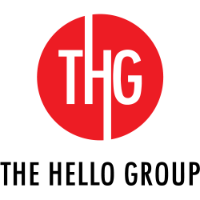
MOMO
Hello Group Inc.
$7.09
0.13
(1.8%)
| Exchange: | |
| Market Cap: | 1.25B |
| Shares Outstanding: | 372.956M |
About The Company
| Sector: | Communication Services | |||||
| Industry: | Internet Content & Information | |||||
| CEO: | Yan Tang | |||||
| Full Time Employees: | 1390 | |||||
| Address: |
|
|||||
| Website: | https://ir.hellogroup.com |
Hello Group Inc. provides mobile-based social and entertainment services in the People’s Republic of China. It operates Momo platform that includes its Momo mobile application, as well as various related properties, features, functionalities, tools, and services. The company’s Momo mobile application connects people and facilitates interactions based on location and interests; and various recreational activities, including live talent shows, short videos, and social games, as well as other video- and audio-based interactive experiences, such as online parties, mobile karaoke, and user participated reality shows. It also operates Tantan, a social and dating application, which enables users to find and establish romantic connections, and meet interesting people; and provides live video, quick chat, value-added, mobile marketing, and other services, as well as mobile games and audio chatrooms. In addition, it allows its platform’s users to livestream a variety of content and activities that comprise talent shows, such as singing, dancing, and talk shows, as well as casual chatting, and other forms of interactions between broadcasters and viewers. The company was formerly known as Momo Inc. and changed its name to Hello Group Inc. in August 2021. Hello Group Inc. was incorporated in 2011 and is headquartered in Beijing, the People’s Republic of China.
Click to read more…
Revenue Segmentation
EPS
Earnings Call
Income Statement
(* All numbers are in thousands)
Balance Sheet
(* All numbers are in thousands)
Cash Flow Statement
(* All numbers are in thousands)
Analyst Estimates
(* All numbers are in thousands)



